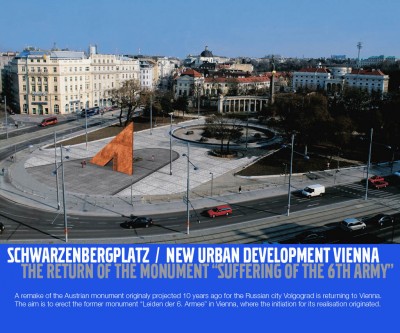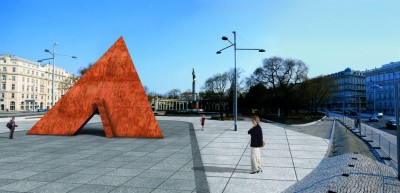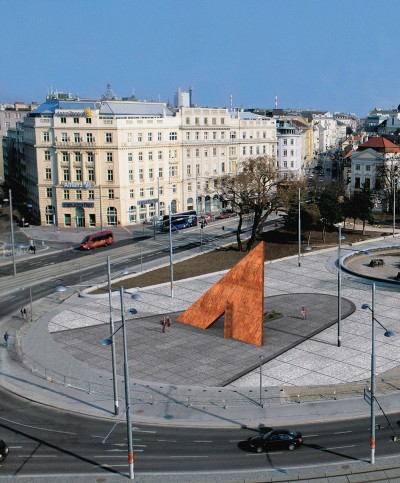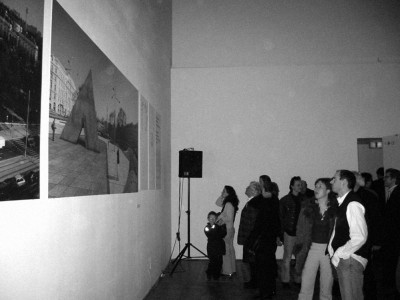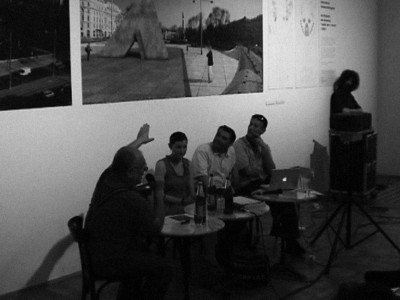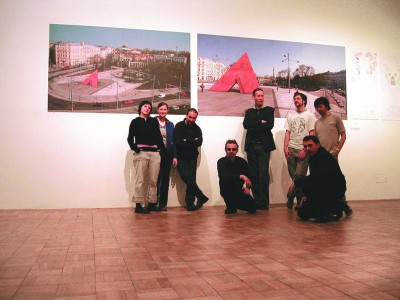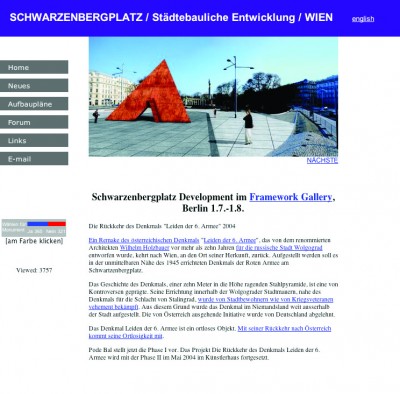LEIDEN DER 6. ARMEE, 2004
Return of the memorial “Suffering of the 6th Army” to Vienna, Niemandsland, Künstlerhaus, Vienna, April -- June 2004
With: Petr Vrána, Martin Šimek, Julia Sonntag
In 1996, Austria unveiled a memorial to the 6th Wehrmacht Army near the city it tried to conquer – Stalingrad (now Volgograd). The monument, in the form of a 20 meter coroded iron thorn, was initialy to be erected in the center of Volgograd. After protests by Russian war veterans and the citizens of Volgograd, it was arranged to be placed 20 km away from the city, where it now stands. Pode Bal decided to propose returning the monument to the place of its origin – the center of Vienna. An urban development project was created, including architectural plans and a visualization of the monument’s new placement: Schwarzenbergplatz, Vienna. This was introduced in the Künstlerhaus as part of the collective exhibition Niemandsland. The initiative was also communicated through the website of a fictive development company, where visitors could vote for or against the return of the monument. Pode Bal conducted video interviews with the former initiators of the Volgograd memorial, Helmut Zilk (former Mayor of Vienna), Wilhelm Holzbauer (architect and author of the steel thorn) and Josef Shantl (the general secretary of Schwartz Kreuz). A pannel discussion was organized in the Viennese Künstlerhaus, moderated by Jan Tábor, author of the exhibition Kunst und Diktaturen.
Press Release - The Return of the "Suffering of the 6th Army"
The voyage of the monument "Suffering of the 6th Army" from Stalingrad through the village Petschanka to Vienna.
The art group Pode Bal is going to erect a remake of the monument "Suffering of the 6th Army" in the center of Vienna.
The original monument had been initiated by Austrians for the 50th anniversary of the Battle of Stalingrad. It was designed by the famous Viennese architect Wilhelm Holzbauer. The monument, reminding a pyramid, thorn or the head of a spear was initially supposed to stand in the center of Volgograd (former Stalingrad).
After a wave of protests by world war II veterans, residents of Volgograd, and disapproval of Germany, the monument's location had been changed for a field outside of the city, in the vicinity of a small village Petschanka. There it had been unveiled in 1996, in the presence of Helmut Zilk, Robert Lichal and other official Austrian representatives.
Pode Bal had decided to erect a remake of the monument in Vienna, on Schwarzenbergplatz, in the near proximity of the Soviet monument, built after the conquest of Vienna in 1945. One member of Pode Bal, Petr Motycka, explained: "The location is very suitable for our intentions. The proximity of the Soviet monument establishes a visual platform for a dialog about recent Austrian history."
"We hope that the Austrian representatives, who backed up the realization of the monument in Russia will also support its recreation in Vienna", said another member of the group, Michal Siml.
The first phase of the project The Return of the Monument "Suffering of the 6th Army" is being introduced since 20.04.2004 in the Künstlerhaus in Vienna as a part of the exhibition Niemandsland. The public can find out more about the project and post comments at www.schwarzenbergplatz-development.org.
Leiden Der 6. Armee / Dialog der Denkmäler
/ Pode Bal (Petr Motycka)
Background: In 1994 the city of Vienna and its Mayor Helmut Zilk initiated a project of erecting a memorial to the “Suffering of the 6th army” in Volgograd, the former Stalingrad. The memorial to the fallen Wehrmacht conquerors who died in the long siege and the following defeat, was created by the Austrian architect Wilhelm Holzbauer. It looks like a gigantic rusty thorn sticking out of the earth 20 meters up towards the sky. The erection of the memorial was organized between the city representatives of Volgograd and Vienna with the Russians getting a shipment of hospital beds, covers and an unspecified financial sum. The new memorial was supposed to stand close to the 80 meter high sculpture of Mother Russia which in contrast commemorates the courage of the defenders of Stalingrad against the Nazis.
In this connection and taking the proportions into consideration, both memorials could enter a dialogue.
The Austrian memorial could be understood to be a sort of a land mine. The realization was complicated by unexpected demonstrations of Russian war veterans and inhabitants of Volgograd which opposed the memorial. Its realization was delayed and the memorial was in the end unveiled in 1996 in the moors of the remote village Pestshanka, 20 km away from Volgograd. The ceremony was visited by Helmut Zilk, the Minister of Defense Robert Lichal and the representatives of the organization Schwarz Kreuz which takes care of the graves and memorials of Austrian soldiers fallen in the Second World War. The memorial provoked us by its content and aggressive form to realize the project Dialog der Denkmäler which is now standing 20 kilometers away from Volgograd. In 1995 the initiative with the memorial of Wehrmacht was discovered by the German daily Der Spiegel which described the whole thing as a shame for Austria.
In the same year Germany officially distanced itself from the initiative and refused to be involved in any way with the memorial. It is worth mentioning that contrary to the Germans the Austrians never attempted to deal with their Nazi history and they aesthetize themselves into the role of the first victim (in 1938 they welcomed the entry of the German Nazi army.)
Hypothesis: The Austrians would not wish the erection of the same memorial, designed for Russia, in Vienna for aesthetic reasons, not to mention the content. At the same time it is not clear how well informed the Austrian public is about the whole issue. We supposed that most people know nothing about the memorial of the “Suffering of the 6th army” and that in the case of slight media attention, there will be some controversial reactions.
Method: The initiation of the return of the memorial “Suffering of the 6th army” from Volgograd into Vienna, projecting its placement in the city centre and directing attention of the public to this intention.
Realization: Under the header of a fictitious developer company we created an urbanist plan of incorporating Holzbauer’s memorial for the Vienna Schwarzenbergplatz, close to the Soviet war memorial which was built to commemorate the conquering of Vienna by the Red Army. The projects of the realization were presented at www.schwarzenbergplatz-development.org and also at Niemandsland, an exhibition in the Viennese Künstlerhaus in 2004. At the same time we contacted the Schwarz Kreuz, Helmut Zilk and Wilhelm Holzbauer and made video interviews with them. In Künstlerhaus we organized a discussion about the return of the memorial to Vienna, which was moderated by an architecture historian Jan Tabor, the curator of the project Kunst und Diktaturen. In 2005 we presented the project in the Berlin gallery Framework, which is oriented mainly towards architecture. At the exhibition we conducted a visitor survey about political and aesthetic functions of Berlin memorials. Further we made an interview with Jakob Schulze-Rohr, the initiator of the Holocaust memorial in Berlin.
Context: Despite our expectation we experienced mainly positive reactions on the side of the former initiators of the memorial “Suffering of the 6th army.” Josef Shantl from Schwarz Kreuz was more or less against moving the memorial, but Holzbauer and Zilk welcomed our initiative. Helmut Zilk even advised us on the realization of the project. Another unexpected reaction to our project was the complete indifference of the Austrian public and press. The discussion in Künstlerhaus had minimum attendance. In Berlin the project called out a bigger interest than we expected.
Continuation: The project should move into Volgograd where the research phase of the reaction of Russian public will be finished. A follow-up exhibition should then take place, summing up the results of the previous phases including interviews with the representatives of the Austrian, German and Russian public. The summarizing exhibition should take place in Vienna, together with the first steps of the transfer of the memorial from Volgograd into Vienna.
A Wehrmacht memorial in Vienna?
/ Jan H. Vitvar
The Czech art group Pode Bal examines the Austrian coming to terms with its war past. How the Czechs deal with their history is what Pode Bal already found out. Now they decided to test the reactions of Austrians. The result so far is somewhat surprising: our southern neighbors are even more indifferent towards their historic misdeeds than we are. Years ago, when the artists put Jan Kavan into their exhibition – called Malík Urvi which showed publicly active people with a past of collaboration with the Communist secret police – he wanted to sue them. Balloons printed with photos of houses of the resettled Sudeten Germans at the Prague Castle were destroyed by the police. The bust which iconized President Beneš and his decrees which was installed at Palacký Square was stolen. Austrians are much more tolerant towards the new action of Pode Bal. Or better said – more lethargic.
Materialized shame
In a long battle for Stalingrad in 1942-1943 the Soviets crushed the 6th army of Wehrmacht. The German estimated losses were 190 thousand dead and 90 thousand captured. After the war, only 5000 returned from captivity. A fifth of them were Austrians, whose overall numbers in the Stalingrad massacre were around 50 thousand. The Soviet losses were around half a million. Their sacrifice in Stalingrad is commemorated by the gigantic statue of Mother Russia. The Austrians wanted to add a memorial of their own suffering eight years ago. The steel memorial for Stalingrad – today Volgograd – was projected by the architect Wilhelm Holzbauer. Its form reminds us of an arrow or a pyramid. Because of the protests from the Russian and partly German side it was finally moved into a distant village Pestshanka, 20 kilometers away. The monument was unveiled there by the former Mayor of Vienna Helmut Zilk and the former defense minister Robert Lichal. In Austria the event led to a small scandal. The Pode Bal group recently decided to revive this sensitive theme. They offered erecting a replica of the monument in the middle of Vienna, at the Schwarzenberg Square, very close to the memorial of the Soviet army. “It is a monster, it looks aggressive. It is actually a sort of materialized shame of Austria”, the memorial is described by a member of Pode Bal, Michal Šiml. The project of its placement in the Austrian metropolis was presented by the group in the exposition Niemandsland which ended in the Vienna Künstlerhaus last Sunday. It didn’t evoke any negative reaction. The group addressed Zilk and Holzbauer and both were enthusiastic. “We expected that they will distance themselves from the cause and especially from the expected reactions of the Austrians. But nothing like that happened,” says Šiml who wants to find out how much the Austrians can bear.
Emotions around Stalin
Pode Bal chose an unconventional way; previously they first came with a finished work, installed it in an exposed place and then watched the responses of the public. This time they chose the opposite way. They wanted to install a realistic model of the monument in Vienna only after having had a public discussion some time in the autumn. And what if the Austrians really wanted to erect the memorial in Vienna? “We will recommend to bring it directly from Pestshanka,” says Michal Šiml. Pode Bal doesn’t plan a similar action in the Czech Republic yet. “There are such emotions linked to the Stalin’s memorial in Prague for example, that it is clear how the Czechs would react to a possible plan of its renewal. And unlike in Vienna, we wouldn’t have anything to reveal,” adds Šiml.
From an interview with Michal Šiml and Petr Motyčka for the magazine Typo, 2004
…But your second project you wanted to talk about, is not a guerrilla installation, there you decided to take an official path.
[mš] I would first say something about the historical background of the project. Ten years ago people in Austria decided to make a memorial to the 6th army (an army of the Nazi Germany – editor’s note) in Volgograd, once Stalingrad. The author of the project was the doyen of Austrian architects Wilhelm Holzbauer. He created a 20 meter high aggressive thorn made out of a corroded iron, which was supposed to be in the center of Stalingrad. Originally it should have been close to the Mother Russia, a statue of liberation of Stalingrad which is an 80 meter high woman with a sword. After publication of the project, Germany distanced itself from it, because the 6th army was mainly formed by Germans. Then the veterans of the Second World War in Russia and citizens of the former Stalingrad started protesting. So there were many problems around it. But in Austria the project evoked a lot of interest. For us that was an unbelievable information: an army which wanted to conduct a genocide on a city later builds a memorial there, and furthermore, called it “The Suffering of the 6th Army”. But in Austria they saw it differently. As the locals said, everyone had a grandfather in the Wehrmacht so the project was agreeable for them.
[pm] It has to do with their belief that Austria was the first victim of Hitler’s Nazi Germany in the Anschluss.
[mš] So they didn’t manage to build the memorial in Volgograd. A few years went by and suddenly a solution presented itself – to erect it in the nearby village of Pestshanka, on the moors. Finally the memorial was unveiled.
The memorial is standing – what actually was your intention?
[mš] When we learned about the project we decided it could be interesting to initiate a return of this memorial back to the place of its origin – to Vienna. Then Jan Tábor invited us to take part in the exhibition Niemandsland in the Viennese Künstlerhaus, which was an exhibition about public space. There we presented the project in the form of a professional architectonical visualization. Our intention was to start a public discussion about this project.
And the result of the exhibition?
[mš] Künstlerhaus is nearly a classic place but people didn’t react at all. We sent many invitations, there was an advert in the Standard (Der Standard is the biggest Austrian daily newspaper – editors note) And during the discussion we were sitting there with seven people from the whole city!
Did you choose a place for the project?
[mš] As a place for the transfer of the monument we chose Schwarzenberg Platz in the center of Vienna. At one end there is a memorial to the conquest of Vienna in the style of Stalinist gothic. It is a thorn in the eye of the Viennese and no wonder, everything in there is written in Cyrillic, even Stalin’s command to conquer Vienna is new and perfectly kept. For the citizens of Vienna it is a foreign element. We offered to erect the 20 meter high memorial of suffering opposite this.
And with that, is the project closed?
[pm] As a part of the project we recorded interviews with the main initiators of the original memorial, the former Mayor of Vienna Helmut Zilk, the author Wilhelm Hölzbauer and the general secretary of the Schwarze Kreuz organization Josef Schantl. We plan to go on with the video-interviews which explain the background of the topics that link the memorials. We want to address Karel Schwarzenberg because he is the closest neighbor to where the memorial should be placed. We want to be tactful... And next week we go to Berlin where we are going through arrangements with the gallery Framework which will show the project next year in the German context.
The Austrian lack of interest reminds me of the Czech lack of interest.
[pm] It is different in Austria. In Czech Republic the lack of interest is more direct, it probably has no secondary motives. In Austria it is a kind of a curious societal program.
This fascination by sculpture, memorial, or monument is interesting.
[pm] The project Return of the Memorial “Suffering of the 6th Army” is one of many which deal with the problem of memorials in general. What does it mean when a memorial is erected in a public space, approved by the dominant ideology of its time.
[mš] Interesting is that in Germany they have two expressions: Denkmal and Mahnmal. Denkmal is a monument which is appreciative, a celebration of something and Mahnmal is a reminder, a warning. The Germans discussed if our project deals with a Denkmal or a Mahnmal. We don’t have this in the Czech language.
But back to memorials...
[pm] A memorial is an object of piety to the present power, establishment and ideology. And a memorial in itself is a language of ideology. It is not usual to criticize a memorial because it is considered a valid expression of collective values through a statue or an object in the public space. And that is something we wanted to play with.
[mš] A memorial is not neutral, it evokes emotions. We can surely remember the pleasure of tearing down statues after the revolution. That’s something nearly mythical.
[pm] A memorial is certainly closely bound to myth, ideology and feelings it awakens. Even when its appearance is comical – from pathos to kitsch, for example. That is a political consequence of this connection. And we want to know what the memorial means in this time and how we can it be changed, how can we change its ideology and how it influences the public space.
